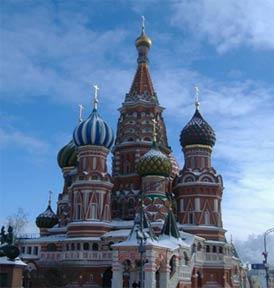
Moscow is bursting at the seams. The core city covers more than 420 square miles (1,090 kilometers), and has a population of approximately 11.5 million people. With 27,300 residents per square mile (10,500 per square kilometer), Moscow is one percent more dense than the city of New York, though Moscow covers 30 percent more land. The 23 ward area of Tokyo (see Note) is at least a third more dense, though Moscow's land area is at least half again as large as Tokyo.
All three core areas rely significantly on transit. Muscovites use the Metro at about the same rate as New Yorkers use the subway, taking about 200 trips each year. Tokyo citizens use their two Metro systems at nearly 1.5 times the rate used in Moscow.
But there are important differences. Moscow officials indicate that approximately two-thirds of Moscow's employment is in the central area. This is a much higher figure than in the world’s two largest central business districts -- Tokyo's Yamanote Loop and Manhattan -- each with quarter or less of their metropolitan employment. Both New York City and Tokyo's 23 wards have extensive freeway lengths in their cores, which help to make their traffic congestion more tolerable.
Moscow's arterial street pattern was clearly designed with the assumption that the dominant travel pattern would be into the core. Major streets either radiate from the core, or form circles or partial circles at varying distances from it. In New York City and Tokyo's 23 wards there are radial arterials, but,the major streets generally form a grid, which is more conducive to the cross-town traffic and the more random trip patterns that have emerged in the automobile age.
Moscow has become much, more reliant on cars, following the examples of metropolitan areas across Europe. The old outer circular road, which encloses nearly all of the central municipality, was long ago upgraded to the MKAD, a 10 lane freeway as long as Washington's I-495 Capital Beltway (65 miles or 110 kilometers). The MKAD has become a primary commercial corridor, with large shopping centers and three nearby IKEAs.
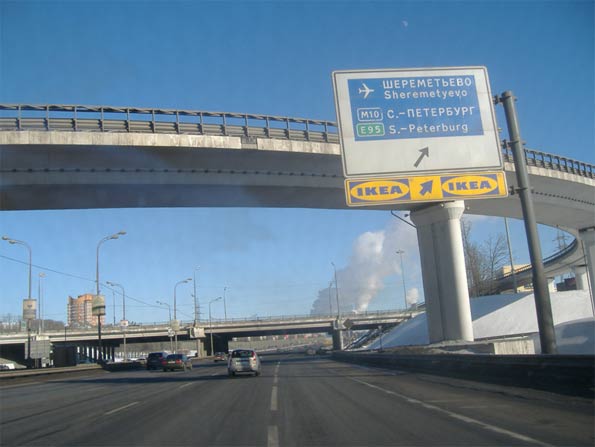
It is not surprising, therefore, that traffic congestion and air pollution became serious problems in Moscow. The road system that had been adequate when only the rich had cars was no longer sufficient. The "cookie-cutter" apartment blocks, which had served Iron Curtain poverty, had become obsolete. The continued densification of an already very dense core city led to an inevitable intensification of intensification of traffic congestion and air pollution.
Transit-oriented Moscow was not working, nor could "walkability" make much difference. In such a large urban area, it is inevitable that average travel distances, especially to work, will be long. Geographically large employment markets are the very foundation of major metropolitan areas. If too many jobs are concentrated in one area, then the traffic becomes unbearable, as many become able to afford cars and use them. Traffic congestion was poised to make Moscow dysfunctional.
Expanding Moscow
The leadership of both the Russian Federation and the city of Moscow chose an unusual path, in light of currently fashionable urban planning dogma. Rather than making promises they could not keep about how higher densities or more transit could make the unworkable city more livable, they chose the practical, though in urban planning circles, the "politically incorrect" solution: deconcentrating the city and its traffic.
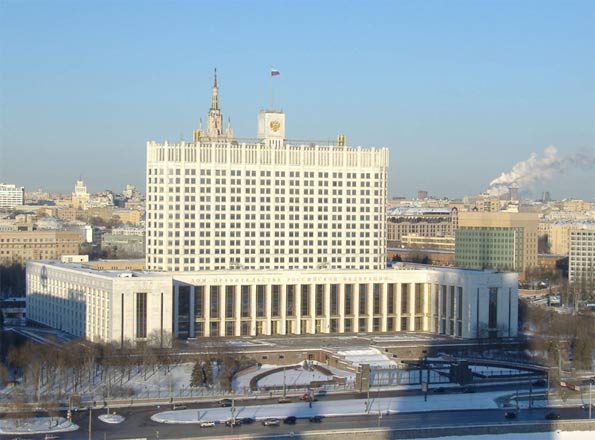
Last year, Russian President Dmitry Medvedev proposed that Moscow be expanded to a land area 2.3 times as large. Local officials and parliament were quickly brought on board. The expanded land area is nearly double that of New York's suburban Nassau County, and is largely rural (Note 2). Virtually all of the expansion will be south of the MKAD.
The plan is to create a much larger, automobile-oriented municipality, with large portions of the Russian government to be moved to the expanded area. Employment will be decentralized, given the hardening of the transport arterials that makes the monocentric employment pattern unsustainable. Early plans call for commercial construction more than four times that of Chicago's loop.
At the same time, the leadership does not intend to abandon the older, transit-oriented part of the municipality. Mayor Sergei Sobyanin has voiced plans to convert central area government buildings into residences and hotels, adding that there will be the opportunity to build underground parking facilities as refurbishments proceed. Moscow appears to be preparing to offer its citizens both an automobile-oriented lifestyle and a transit-oriented one. The reduced commercial traffic should also make central Moscow a more attractive environment for tourists, who spend too much time traveling between their hotels and historic sites, such as the Kremlin and St. Basil's.
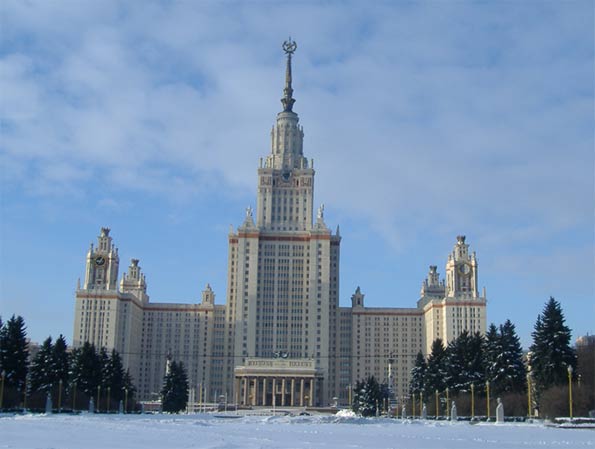
Expanding the Family?
As Moscow expands, the national leadership also wants the Russian family to expand. Russia has been losing population for more than 20 years. Since 1989, the population of the Russian Federation has dropped by 4.5 million residents. When the increase of 3.0 million in the Moscow area is considered, the rest of the nation has lost approximately 7.5 million since 1989. Between the 2002 and the 2010 censuses, Russia lost 2.2 million people and dropped into a population of 142.9 million. Russia's population losses are pervasive. Out of the 83 federal regions, 66 lost population during the last census.
Continued population losses could significantly impair national economic growth. The projected smaller number of working age residents will produce less income, while a growing elderly population will need more financial support. This is not just a Russian problem, but Russia is the first of the world's largest nations to face the issue while undergoing a significant population loss.
The government is planning strong measures to counter the demographic decline, increase the birth rate, and create a home ownership-based "Russian Dream". Families having three or more children will be granted land for building single-family houses across the nation., including plots of up to nearly one-third of an acre (1,500 square meters). Many of these houses could be built in Moscow's new automobile- oriented two-thirds, as well as in the extensive suburbs on the other three sides of the core municipality.
Expanding Outside the Core
While population decline is the rule across the Russian Federation, the Moscow urban area has experienced strong growth. Between 2002 and 2010, the Moscow urban area grew from 14.6 million to 16.1 million residents (Note 3). This 1.3 percent annual rate of increase exceeds the recently the recently announced growth in Canada (1.2 percent). This rate of increase exceeds that of all but 8 of the 51 major metropolitan areas (Note 4) in the United States between 2000 and 2010.
While the core district grew 6 percent and added 41,000 residents, growth was strongest outside the core, which accommodated 97 percent of the new residents (See Table). Moscow's outer districts grew by nearly 1.1 million residents, an 11 percent increase, and its suburbs continued to expand, adding 400,000 residents, an increase of 10 percent. These areas have much lower densities than the city, with many single-family houses.
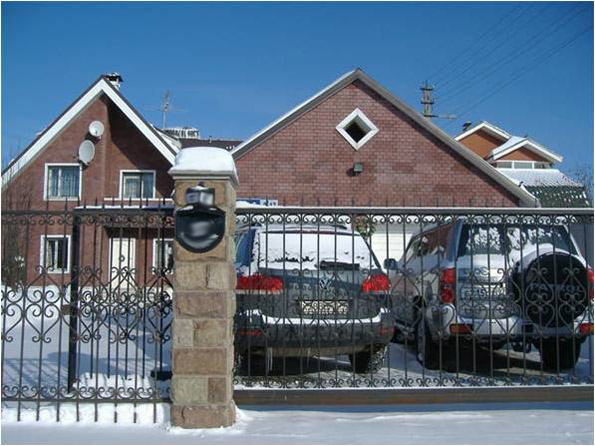
| Table | |||||
| Moscow Urban Area Population | |||||
| 2002 | 2010 | Change | % Change | Share of Growth | |
| Inner Moscow | 701,000 | 743,000 | 41,000 | 5.9% | 2.7% |
| Outer Moscow | 9,681,000 | 10,772,000 | 1,090,000 | 11.3% | 70.3% |
| Suburban | 4,198,000 | 4,617,000 | 420,000 | 10.0% | 27.0% |
| Total | 14,581,000 | 16,132,000 | 1,551,000 | 10.6% | 100.0% |
| Note: Suburban population includes the total population of each district and city that is at least partially in the urban area. | |||||
Moscow, like other international urban areas, is decentralizing, despite considerable barriers. The expansion will lead to even more decentralization, which is likely to lead to less time "stuck in traffic" and more comfortable lifestyles. Let's hope that Russia's urban development policies, along with its plans to restore population growth, will lead to higher household incomes and much improved economic performance.
Wendell Cox is a Visiting Professor, Conservatoire National des Arts et Metiers, Paris and the author of “War on the Dream: How Anti-Sprawl Policy Threatens the Quality of Life”
-----
Note 1: The 23 ward (ku) area of Tokyo is the geography of the former city of Tokyo, which was abolished in the 1940s. There is considerable confusion about the geography of Tokyo. For example, the 23 ward area is a part of the prefecture of Tokyo, which is also called the Tokyo Metropolis, which has led some analysts to think of it as the Tokyo metropolitan area (labor market area). In fact, the Tokyo metropolitan area, variously defined, includes, at a minimum the prefectures of Tokyo, Kanagawa, Chiba and Saitama with some municipalities in Gunma, Ibaraki and Tochigi. The metropolitan area contains nearly three times the population of the "Tokyo Metropolis."
Note 2: The expansion area (556 square miles or 1,440 square kilometers) has a current population of 250,000.
Note 3: Includes all residents in suburban districts with at least part of their population in the urban area.
Note 4: Urban area data not yet available.
Photo: St. Basil's Cathedral (all photos by author)













Road in City Area
The roads and ways of the city areas are very clumsy and many accidents are happening due to the short road. But you need to maintain the driving properly otherwise you may face accident. So now the government decided to expand the road which may put the positive effect on automobile sector. I think it is a helpful service for the society people. If you have a BMW car and you have faced any problem then better to repair it at BMW Repair Spring, TX for the best service.
Transit & transportation
Transit and transportation services are quite impressive in most of the urban cities; therefore people were getting better benefits from suitable transportation service. Urban cities like Moscow, Washington, New York and Tokyo; we have found high margin of transportation system that helps to build a better communication network in these cities. I hope through the help of modern transportation system we are able to bring revolutionary change in automobile industries; in this above article we have also found the same concepts to develop transportation system.
Mercedes repair in Torrance
Moscow is bursting Noblesse
Moscow is bursting Noblesse at the seams. The core city covers more than 420 square miles (1,090 kilometers), and has a population of approximately 11.5 million people. With 27,300 residents per square mile (10,500 per square kilometer), Moscow is one percent more dense than the bleach anime watch city of New York, though Moscow covers 30 percent more land. The 23 ward area of Tokyo (see Note) is at least a third more dense, though Moscow's land area is at least half again as large as Tokyo.
All three core areas rely
Belgravia Villas is a new
Belgravia Villas is a new and upcoming cluster housing located in the Ang Mo Kio area, nested right in the Ang Mo Kio landed area. It is within a short drive to Little India, Orchard and city area. With expected completion in mid 2016, it comprises of 118 units in total with 100 units of terrace and 18 units of Semi-D.
belgravia villas
Russians seeing the light while Western elites are bickering?
What an extremely interesting analysis - well done, Wendell.
It is also extremely interesting that the Russian leadership is reasonably pragmatic about urban form, in contrast to the "planners" of the post-rational West.
An acquaintance recently sent me an article from "The New Yorker", re Moscow's traffic problems.
The article "abstract" is HERE (but access to the full article requires subscription)
http://www.newyorker.com/reporting/2010/08/02/100802fa_fact_gessen
One classic quote worth taking from it, is: "People will endure all manner of humiliation to keep driving".
I do find it odd that the "New Yorker" article author says nothing at all about the rail transit system Moscow had, on which everyone was obliged to travel, under Communism. It can't surely have vaporised into thin air?
Moscow is a classic illustration of just how outmoded rails are, and how important "automobility" is, when the auto supplants rails so rapidly than even when everybody did travel on rails up to a certain date, and the road network dates to that era, when nobody was allowed to own a car; an article written just 2 decades later does not even mention the rail transit system, other than to criticise the mayor for "failing to invest in a transit system".......!!!!!!!!
This is also a give-away of "The New Yorker's" inability to shake off the modern PC ideology on rails vs cars.